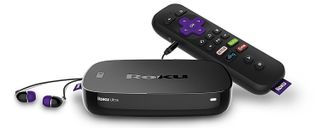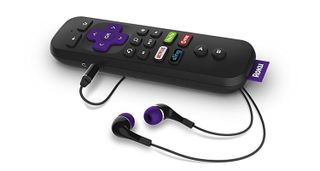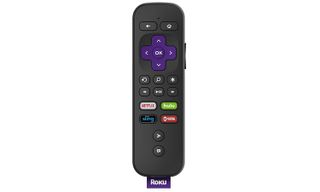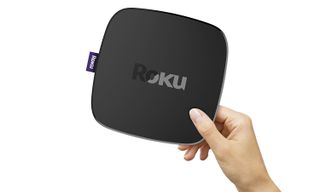Roku Ultra Review — The Media Streamer to Beat
The Roku Ultra lives up to its name, with 4K resolution, HDR support, digital audio, USB connectivity and more than 3,500 channels.
Why you can trust Tom's Guide

The Roku Ultra claims to have it all, and the device really delivers. You want 4K resolution, HDR support, digital audio, USB connectivity, a remote control with voice search and a headphone jack, and more than 3,500 streaming channels? The Roku Ultra has them. Unless you hook up a PC to your TV, you're not going to find a more complete media streamer, or a more powerful one.
Design
Imagine a Roku 4 — a large, clunky black box with a noisy fan. Now imagine it smaller and quieter, and that's the Roku Ultra in a nutshell. The Roku Ultra is a relatively small, square-ish device, at 4.9 x 4.9 x 0.9 inches. Roku's engineers have also figured out better ways to cool the device, resulting in a fanless media player that no longer sounds like a jet engine warming up next to your TV.

The back and sides of the device are well-adorned, too, with enough ports to please even the most discerning videophile. In addition to power and HDMI ports, there's also an Ethernet port, a digital audio output, a microSD card slot and a USB port. With Roku's built-in media player (or a more comprehensive app, if you have obscure file extensions), you can play almost anything from your own media library, and with high-res audio to boot.

I have one criticism about the Roku Ultra, however: For the price, it should really come with an HDMI cable. If the $30 (and decidedly mediocre) Roku Express can come with one, there is absolutely no reason why Roku should withhold a vital component from the most dedicated users.
MORE: Best Streaming Players: Chromecast, Roku, Apple TV & More
Interface
Roku's operating system has not changed significantly in the past few years, although I would argue that not much about it needs changing. Getting around is extremely simple, and because the Roku Ultra is a powerful system, it's extremely fast, too.
The Roku Ultra has a lot to prove, and in my experience, it succeeds in almost every way.
Roku's home screen puts your channel selection front and center, showing you the apps you've downloaded and even letting you move them around to prioritize your favorites. (I've said it before, but it's positively embarrassing that competitors like the Amazon Fire TV and Nvidia Shield don't allow this incredibly useful function.) From there, you just use the remote to get in and out of apps as you see fit.

In fact, there's not a whole lot you can do on the Roku Ultra aside from accessing your apps. The home screen lets you search for content, mark movies and TV for future reference in "My Feed," browse the Fandango movies and TV store (Roku's preferred provider), read some headline news, browse for new channels, and get into the settings menu. You can even remove the adventitious Fandango and news screens, if you prefer, leaving you with just the essentials for navigation.
Like other Roku devices, the Roku Ultra offers a voice search, which generally works well. You can use either the remote control or the mobile app to simply speak the name of a show, actor, director or app, and see what Roku comes up with. Although you need to give both the remote control and the mobile app a second or two to register before you start talking, the voice recognition is pretty accurate. Shows like Star Trek and actors like Peter Capaldi showed up immediately when I searched for them.
Roku's remote controls have been getting consistently better with each new streaming player.
The Roku Ultra's interface is a little too colorful and crowded to call it "minimalist," but it does put as few barriers as possible between you and your content. Plus, one of the themes makes it look like a sci-fi view screen, so it earns a few points for that.
Remote
Roku's remote controls have been getting consistently better with each new streaming player. While they're still not quite as streamlined as they could be, they're almost there. The Roku Ultra's remote has a matte finish and a somewhat thinner profile than its predecessors. It's not quite as skinny as the Roku Stick or Express remotes, since it does include an audio jack for private listening and a mic for voice search, but those seem like fair trade-offs.

The Roku Ultra remote also has a surfeit of buttons, although nothing is really extraneous. Back and Home fill out the top row, with a directional pad and an OK button underneath. Then, there are buttons for instant replay, search, options, rewind, play/pause and fast-forward. At the bottom of the remote are two extra buttons for gaming. So far, so good.
My perennial complaint about Roku remotes still applies, however. The Roku Ultra remote features built-in buttons for Netflix, Hulu, Sling TV and Showtime. Not every consumer is going to use these four apps, and it would make a lot more sense to let users program their own favorite channels.

If you misplace the remote, you can also navigate with Roku's mobile app. The app does pretty much everything the remote control can do: voice search, text search, text entry and private listening. Roku's search is pretty much the best in the business, as it covers more than 100 providers, from Netflix to Google Play to Amazon Video to much more niche providers.
If you're going to shell out $130 for a 4K media player, it's good to have an app that finds movies and shows in the highest resolution available.
Now that Roku has cleaned up some bugs with the private-listening features, there's not much else to say about it. It's a good backup, although not strictly necessary; the Roku Ultra comes with a remote finder feature that can help you locate missing peripherals via loud pings (or even selections from Wagner).
Content and Apps
One area where other streaming players can't touch Roku is app selection. Every Roku player, including the Ultra, has access to more than 3,500 channels. The Ultra and other high-end systems can also access dozens of channels in 4K, rather than just the Netflix/YouTube/Amazon trifecta common to smart TVs and other, less versatile players.
All of the usual suspects are present and accounted for, including Netflix, Hulu, Amazon Video, YouTube, Google Play, Sling TV, PlayStation Vue, Pandora, Spotify, YouTube and Crackle. I can't think of a single major provider whose content is not available on Roku, excepting perhaps iTunes — and good luck getting Apple to loosen that leash.
I should also call out the 4K Spotlight app, which Roku employees use to highlight UHD content across a variety of services. If you're going to shell out $130 for a 4K media player, it's good to have an app that digs beneath the surface of 4K content and finds movies and shows that you may not have known about and that are in the highest resolution available. (Everyone should watch Deep Time History. Seriously. It's temporal astrophysics meets world history, like Carl Sagan's Cosmos on methamphetamines.)
MORE: Best Devices to Sling Your Phone or Tablet to a TV Screen
Performance
The Roku Ultra is a technological behemoth, with a quad-core processor, full 4K output, and support for both HDR and Dolby audio. Hopping from menu to menu takes no time at all, and opening apps takes just a few seconds. While video quality is arguably more dependent on the strength of your internet connection, I observed most videos stabilizing at full 4K resolution within 15 seconds or so. Full HD took even less time.

While the Roku Ultra is essentially an updated version of the Roku 4, it's also worth pointing out their differences, all of which help make the Ultra much better than its predecessor. First and foremost, the device is smaller and quieter, as discussed above. Support for HDR and Dolby is new, as is a Night Listening mode. This helps amp up dialogue and tone down big explosions so that you can watch TV in the living room without waking housemates late at night.
The Roku Ultra is a powerful device, but it's not just for show; it makes full use of its processor to support the latest and greatest visual and audio innovations.
Roku Ultra vs. Apple TV and Nvidia Shield
In a similar price range, you could consider the Apple TV ($150) or the Nvidia Shield TV ($200). The Siri remote on the Apple TV is particularly compelling for finding content, and it offers a growing array of apps and games. However, that box lacks 4K resolution and HDR support.
The Nvidia Shield TV, on the other hand, has excellent options for gamers — particularly those who already have fancy gaming PCs — and also supports 4K and HDR content. However, it's not worth dropping an extra $70 if you'd rather watch than play, especially since the Shield's Android TV OS offers hundreds of channels rather than thousands.
Bottom Line
With a $130 price tag, the Roku Ultra had a lot to prove, but in my experience, the device has succeeded in almost every way. The physical product is small and unobtrusive; the interface is snappy and functional; the channel selection is unparalleled, and the extra features have real utility for videophiles of both the casual and hardcore persuasions.

While the system absolutely should have included an HDMI cable and the remote is a few iterations away from perfection, these quibbles do little to detract from what is otherwise one of the best streaming players on the market today.
If you have a 4K, HDR-compliant TV and want to watch everything on it — not just the obvious choices — the Roku Ultra is very nearly a necessity.
Sign up to get the BEST of Tom’s Guide direct to your inbox.
Upgrade your life with a daily dose of the biggest tech news, lifestyle hacks and our curated analysis. Be the first to know about cutting-edge gadgets and the hottest deals.
Marshall Honorof is a senior editor for Tom's Guide, overseeing the site's coverage of gaming hardware and software. He comes from a science writing background, having studied paleomammalogy, biological anthropology, and the history of science and technology. After hours, you can find him practicing taekwondo or doing deep dives on classic sci-fi.

